Game 150, Part II: The Crew

In November 2013, The MMQB was granted unprecedented access to an NFL officiating crew before, during and after a Ravens-Bears game at Soldier Field—dubbed Game 150 because that’s the number the NFL assigned it, out of its 256 regular-season games. Part 1 of the three-part series looked at referee Gene Steratore. In Part 2 we delve into the lives of the other members of the crew: umpire Bill Schuster, line judge Jeff Seeman, side judge Mike Weatherford, field judge Bob Waggoner, head linesman Wayne Mackie and back judge Dino Paganelli, with a focus on those last three. Part 3—the crew’s preparations on Saturday, and Sunday’s game.
Tuesday, Nov. 12
Glass Bowl, Toledo, Ohio
It’s an Arctic night at the Glass Bowl, the football stadium on the campus of the University of Toledo. There aren’t many folks in the house wearing sportcoat and tie, but Bob Waggoner is one. Waggoner, the field judge on referee Gene Steratore’s NFL crew, is here on official business, as the assistant supervisor of officials of the Mid-American Conference, to observe referee Stan Evans’ crew for the Buffalo-Toledo game. “It gives us an opportunity to educate those who are eventually going to take our place someday,” Waggoner says.
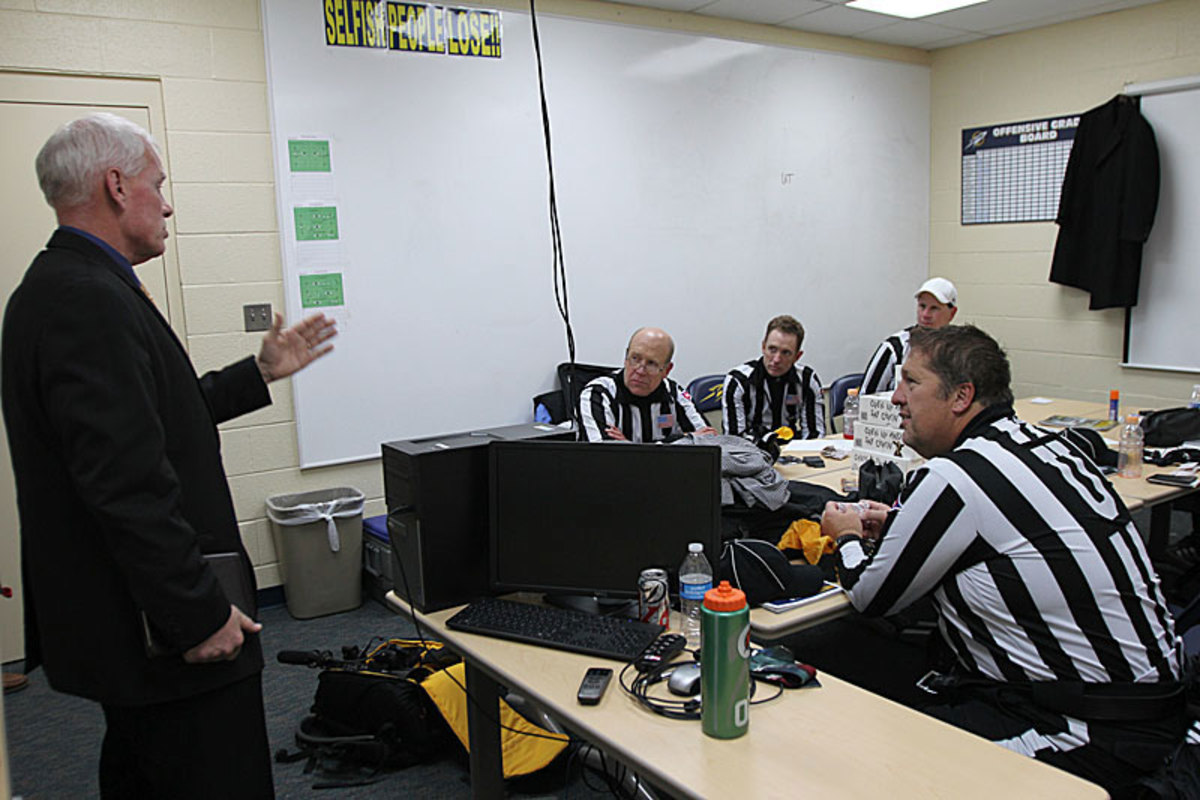
The game is interminable—3 hours, 46 minutes; Toledo 51, Buffalo 41—but the length does afford Waggoner the chance to join the weekly NFL crew conference call. After Steratore, also a Division I basketball official, finishes his hoops game in Ann Arbor that night, he convenes his seven-man crew for the inside-officiating review of the previous week’s league grades and what the crew could do to improve in several areas, including helping others on the crew with a call if a far-flung official might have had a better view of a foul. Waggoner is a mostly silent participant, listening for about 45 minutes while watching the Bulls and Rockets slug it out from the Glass Bowl press box.
“The crew concept is the crux of what we do,” Waggoner says at halftime. “You have to have confidence in everyone on the crew. That’s how things get done correctly. The building of the trust between all the men on the crew is so important, because you have to rely on them sometimes as an extra set of eyes. The only time I really like to throw my two cents in is when I have seen a play from beginning to end and I am sure of what I saw. If there’s a disagreement on what to call, I’ll say, ‘Did you see the play from beginning to end? Because I did.’”
Waggoner has one primary critique of the officiating in the Buffalo-Toledo game: This MAC crew has to move the game along faster. The poor fans were exposed to the 23-degree wind chill for so long they left the stadium as walking blocks of ice. Waggoner enters the officials’ room after the game and first reviews several calls—such as offsetting penalties for personal fouls when it seemed clear that the Toledo player started things. “I don’t like offsetting fouls,” Waggoner says to the official who called it, who nods in understanding. “Get the instigator.”
Then he conveys his main point to Evans, the referee: Don’t wait till you place the ball down before you start the clock after stoppages; you can start the clock a few seconds before that, as soon as the ball gets in your hands. Those six or eight seconds, on 40 or so stoppages during an average game—one with undefined TV timeouts and the ridiculousness of stoppages every time a first down is gained (there were 49 tonight)—are going to add up and move things along more briskly.
“Maybe I’m old school,” says Evans, “but the way I was taught, you have to … ‘’
“Stan,” Waggoner says gently but firmly, “let me tell you about that old school. The old school is closed. There are no students there anymore. They’re in a new school now. That’s the school you’ve got to go to now.”
That’s one way NFL concepts seep down into college football. Several current and former NFL officials work as supervisors or graders for college conferences and try to import some pro ideas regarding officiating. This is Waggoner’s other job. In a typical week at his Toledo home, he’ll spend about three hours Monday watching the previous day’s NFL game; concentrate Tuesday on the plays he either erred on or was questioned about; look Wednesday and Thursday at training tapes and video of both of the upcoming NFL teams he has that weekend; work out several times (the NFL monitors its officials’ in-season weight); talk with the NFL’s field-judge adviser, an extra officiating resource who reviews the positioning and mechanics of each field judge (each position has such an adviser); and take a weekly 15-question test.
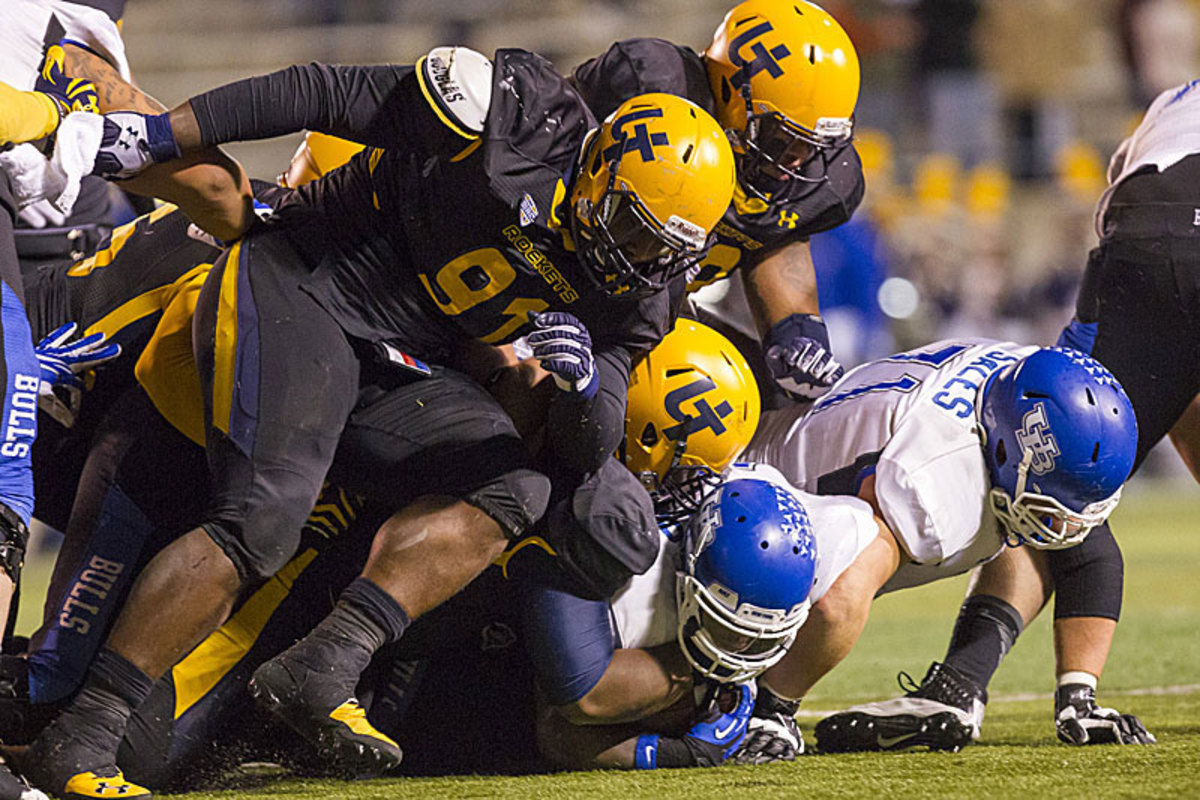
It’s all part of the weekly mosaic. “We do as much preparation as the teams do,” Waggoner says. That’s an exaggeration, of course—six of the seven guys on Steratore’s crew have jobs entirely apart from football officiating. But Waggoner, in his other job and his weekly prep, does practice football immersion most days.
Wednesday, Nov. 13
Wyoming High School, Wyoming, Mich.
There have been some controversial calls in our time. Can you think of one more controversial than the Calvin Johnson didn’t-complete-the-action-of-a-catch-while-going-to-the-ground play that decided the Lions-Bears game on opening day 2010? Johnson caught what appeared to be the winning touchdown pass at Chicago, took a couple of steps while falling, used the ball to brace his fall, and the ball popped free when it contacted the ground. The back judge on the play, the man whose call it was, Dino Paganelli, ruled no catch. Upon review, the referee, Gene Steratore, upheld Paganelli’s call, and the Lions lost the game.
Paganelli returned that night to his home in Wyoming, Mich., next to Grand Rapids, two hours west of Detroit. Lions country. And the next day he headed to his job as a teacher at Wyoming High.
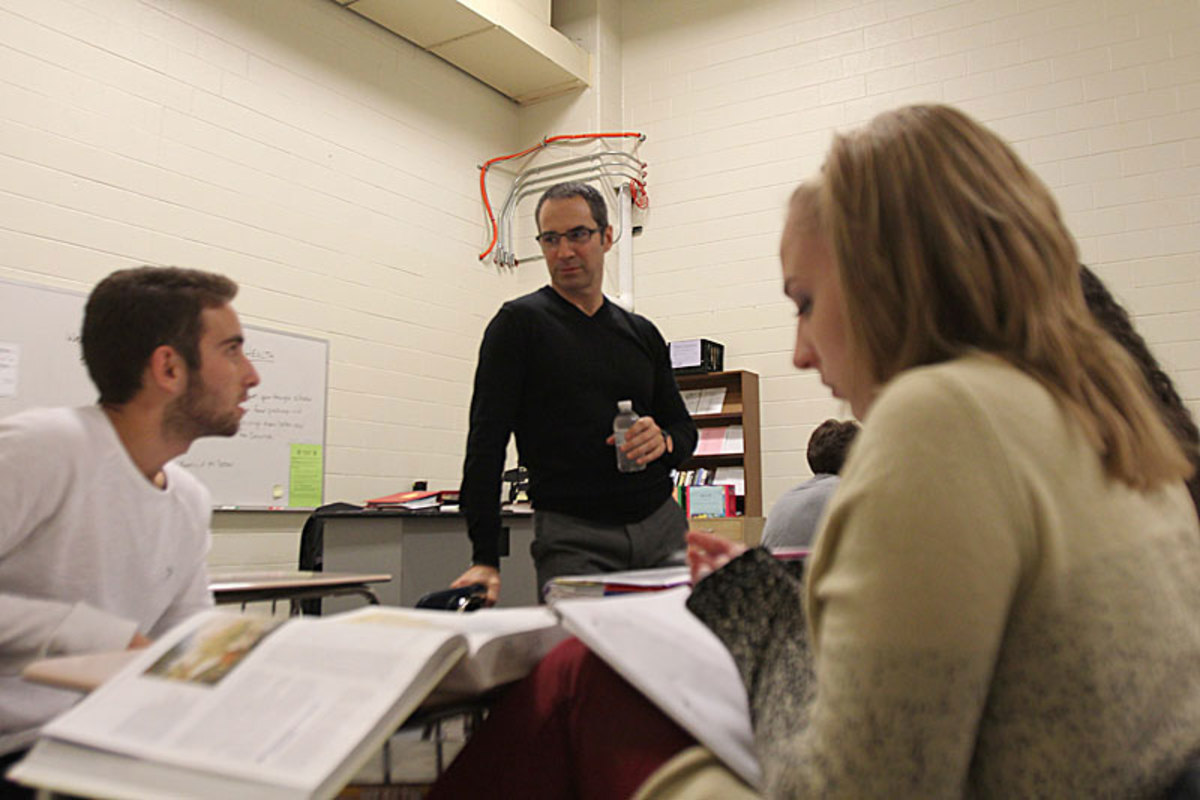
“Oftentimes I get more harassment from my students in phys ed class than I do from players on the field,” Paganelli says. “That Monday the students wouldn’t talk to me, they wouldn’t listen to me. They just shut down; they wouldn’t let me teach. Then you try to explain what the rule and the process is, and they’re not buying it. To this day, when I call a foul in flag football, it’s, ‘Oh, that’s the Calvin Johnson referee.’ ”
So much for home (ref) cooking. As onerous as you might find the rule in the Calvin Johnson play, if the Michigan guy doesn’t call the play the way he did, the Michigan guy would have gotten a downgrade from the league office when grades were made official three days later. A few downgrades and you won’t officiate in the playoffs. A few more and you’ll be quietly let go after the season. As one of the members of Steratore’s crew, head linesman Wayne Mackie, a New Yorker, says, “I like my job. You think I’m going to risk it by throwing flags for the Jets when I work a Jets game?” This is a subject the seven officials on the crew bring up quite often, usually shaking their heads in incredulity. “At the end of the game, most times, we don’t even know the score,” Mackie says.
“It’s about personal integrity,” Paganelli says, “and protecting the NFL shield.”
Now for Paganelli’s weekday job. On this day at Wyoming High, the Calvin Johnson referee—who is a phys ed and AP History teacher when not on an NFL field—has put today’s assignment on the blackboard in this middle-class ’burb. It would fit nicely in a college-frosh History 101 class.
AP History Writing Prompt
Analyze the political, diplomatic and military reasonsfor
the United States’ victory in the Revolutionary War.
(Confine your response to the period 1775-1783.)
* Be prepared to present your message to the group.
The students break into small study groups for the last half-hour of the period. “Challenge yourself,” Mr. Paganelli says. “Work with people you haven’t worked with in the past.” As the kids pick small teams, Paganelli walks from group to group with advice and ideas.
Big dreams among the 30 students in here. Two boys in ties sit attentively. One of the girls hopes to be admitted to Northwestern; another is leaning toward the University of Washington. When Paganelli took over the class, he found there was a great emphasis on testing. “I was told, ‘You’ve got to kill Lincoln by Thanksgiving,’ ” he says. “That’s tough. I’m not a fan of testing twice a week. I’m a fan of thinking. Kids have to learn to think.’’
Critical thinking. For a back judge it’s vital. Paganelli, who worked last year’s Super Bowl, is the last line of defense on the Steratore crew. He has to think fast on interference calls, and he has to think faster on catch/no-catch and boundary plays. He has to watch for the kinds of helmet-to-helmet hits, and hits on defenseless receivers, that have become a flashpoint in officiating in the past three years. He watches for those after he monitors the 40-second play clock (it’s his primary call if it expires), count the number of defensive players after final substitutions are made, and figure out which receiver is his in the multiple-receiver formations that dominate the game today.
It’s one of the more complicated elements of the game for an officiating crew, and one we never think about. With motion and multiple-receiver sets and backs flanked out and tight ends split wide, how do the seven men figure out who’s watching which players? Say the offense comes out with three receivers to the right and one to the left. In this case, the side judge takes the widest receiver, the head linesman the middle man and Paganelli, the back judge, takes the receiver closest to the formation. The field judge takes the lone receiver on the left.
Now, say one of the three from the right goes in motion. Once he crosses the center of the formation and relocates to the left, Paganelli would switch to the closest receiver to the formation on the referee’s side—usually the offensive right side.
Now, say the three receivers stay in a bunch to the right, either stacked or too close to figure left, right and middle in the second or two before the snap. “Then,” says Paganelli, “we let them declare as they run upfield. It’s a feel play then. The side judge will take the receiver who goes to the outside, or becomes the widest of the three. The head linesman takes the short receiver or the receiver to the flat. The back judge takes the receiver who heads upfield or becomes the third receiver if they declare their routes quick. But most of the time the back judge will take the receiver coming straight upfield.”
Now, say it’s an all-go out of a bunch formation, with all three men sprinting upfield together. Again, it has to be a feel thing: Just think, side judge on the outside receiver, head linesman the next one in, and the back judge the third one.
“That’s one of the reasons why it’s important to have crew chemistry,” says Paganelli. “There are so many things that happen suddenly, and you need to know how your partners are going to see things, so you know what your assignment is going to be.”
When Paganelli goes home from school every day, he enters a far different, far more difficult world. In 2011, his wife, Christine, died at age 40 of melanoma. The disease dragged on for a couple years, and it was torturous for Dino and her, mostly because of their three children. Now Brady is 14, Jake 13 and Katelyn 6. It’s like you’d think: Every day’s a struggle, even in the day-to-day normalcy of the family routine two-and-a-half years later. Jake wants a cell phone. Katelyn needs Dad home when she steps off the school bus just before 4. Life with three kids. On this day, Paganelli’s mother, Mary, is here to take Jake to basketball practice and to oversee Katelyn’s play date.
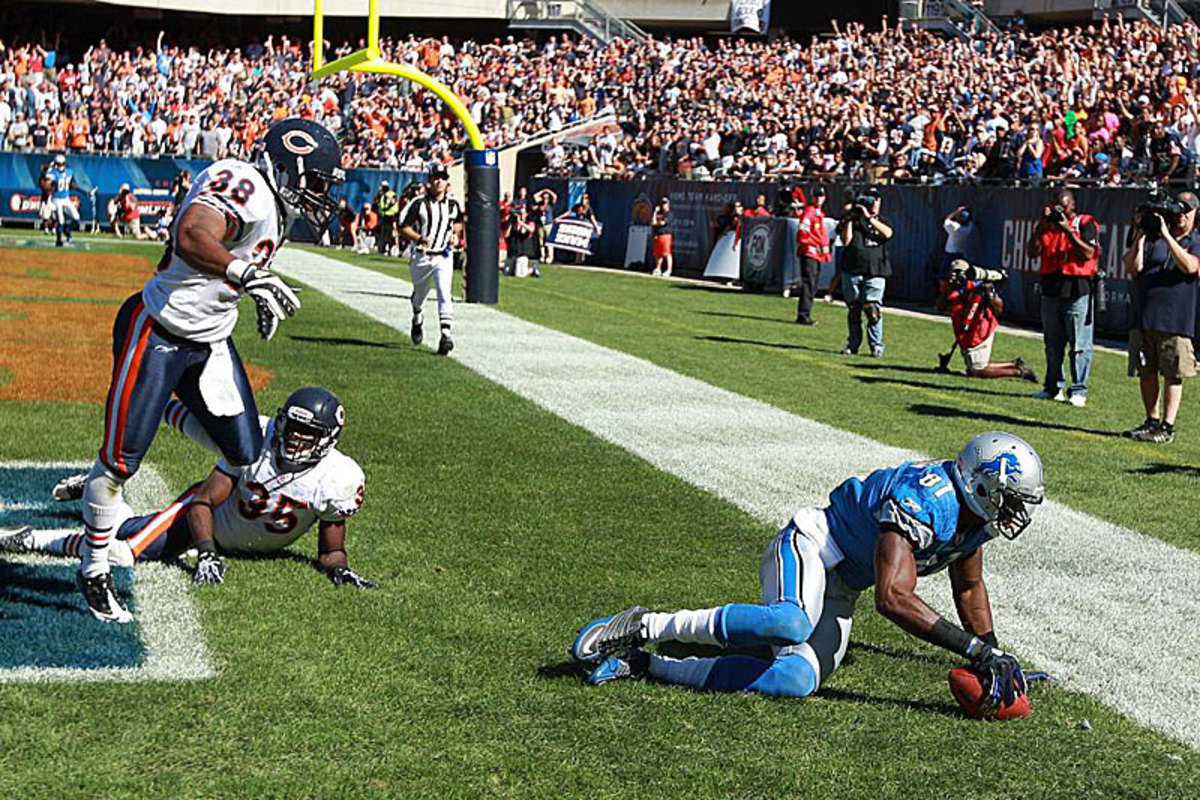
Paganelli has NFL homework to do at the dining room table, his NFL-issued Surface tablet set up to review some plays from Sunday and look ahead to Game 150. Before he does, I ask him about life as a single dad raising three kids.
“I’m lucky to have all the help and support I have from two families,” he says. “Without that I’d be lost. But if there came a time that I had to step away because of my family, I wouldn’t think twice about it.” The pressure on the field, he says, doesn’t compare to the pressure of raising three kids as a single parent. As he says: “Officiating isn’t pressure. Pressure is getting home at midnight Sunday from a game and making sure there’s milk in the refrigerator for breakfast for the kids, and making sure their clothes are washed and ready for the week.’’
Doorbell rings. Paganelli looks around. No one answers it. He goes to the door, and there’s a little girl. “Is Katelyn home?” she says. Paganelli lets her in, and she and Katelyn have some fun in the den while he goes back to his tablet.
My question is about the hot-button issue of today: How do you officiate the bang-bang calls in the secondary, with the emphasis on player safety? How do you see the helmet-to-helmet hits at full speed? How do you divine what is a hit on a defenseless receiver, with players moving as fast as they do?
“I’ve got a good example for you, to show you how tough it is,” he says. For this, Paganelli hits his touch screen, and here’s the Week 4 Arizona-Tampa Bay game, with the Steratore crew working. Late in the second quarter, Bucs tight end Tim Wright catches a pass up the right seam from Mike Glennon, and Cardinals safety Yeremiah Bell comes and blasts Wright in the upper torso—and maybe the head. Wright’s head snaps back. A flag comes flying in, but not from Paganelli. There’s a crew conference. Paganelli says he thinks Bell hit Wright low enough; legally. Others think differently. Line judge Jeff Seeman threw the flag, and his argument in the conference wins. Pretty understandable. From where he stood, Seeman saw the violent collision, and Wright's head snapping back, at a high rate of speed. Steratore announces, “Personal foul, unnecessary roughness, hit on a defenseless receiver … ”
Paganelli plays it over a few times. “Here, I’m looking for the missile, because we’ve been challenged by the league to improve our recognition on plays like this. Let’s watch …” Now it runs two, three, four times. The more you see it, the more you see Bell putting his head to the side, so as not to hit Wright with it. And you see his shoulder pads nail Wright in the upper-sternum/shoulder-pad area. There doesn’t appear to be any contact with the head. The head just snaps back because of the jarring hit to the upper torso. There's something about watching these plays over and over and over again. Steratore put it best. "Sometimes," the ref said, "it's like you're watching the Zapruder film and trying to figure out what exactly happened."
“This is not a foul,” Paganelli says. And I believe he’s right. “You see 37 uses his shoulder, not his head, and go shoulder-to-shoulder.’’
On the TV copy of the game, FOX’s Sam Rosen intones: “If there’s a mistake, they’re going to err on the side of player safety.” He’s spot on.
“I do think defensive players are getting better,” Paganelli says. “We have become much more sensitized to the hits, and we’re better at recognizing them. Defensive players are playing smarter; I’m sure of it.’’
Postscript: The league supported the call, and didn’t give a downgrade to either official, Seeman or Paganelli, because it was so close. “Support” usually means the call was technically incorrect but so close they’re not going to sanction either official.
“There’s a quote from Pat Riley that I like,” Paganelli says. “ ‘I know I’m good. I know I can get better.’ That really says a lot about our jobs.”
Yes, it does. But after three days of looking at close calls, my conclusion on the “I can get better” angle is this: It doesn’t matter how good you get. Officials are still going to miss some, or quite a few. On the play in the Bucs-Cards game, two smart officials saw it in real time, and saw it exactly differently. Earlier in the week I had watched a play with Steratore for 15 minutes before feeling convinced it wasn’t a foul—and even then Steratore wasn’t convinced he wasn’t going to get downgraded for it.
Mistakes are going to happen. And there’s precious little these guys can do about it.
Thursday, Nov. 14
New York Department of Housing Preservation & Development, Lower Manhattan
Head linesman Wayne Mackie’s real-world office is maybe 12 miles from the place he works one or two weekends a year—MetLife Stadium in New Jersey. But talk about two different worlds.
To get to Mackie’s office you wade through a unsettling horde of people unhappy with some aspect of their housing, check in with security, sign in and get a badge, and pass through the X-ray machine. You ride the elevator up to 6, enter the world of Division of Neighborhood Preservation director of operations Wayne Mackie, and sit in while he gets a report from a meeting with housing officials and 80 residents of Coney Island, Brooklyn, unhappy that, 13 months after Hurricane Sandy, their places are still struggling to get up to code.
“They’re mad about Sandy recovery, and the communication, and the city’s response,” said Pam Glaser, the department’s director of public outreach and education. Seems that Glaser publicly reached out and tried to educate, but the unhappy Coney Islanders were having none of it. And now that’s hit Mackie’s desk.
“No one likes the fact that they call 311 [the number for information or help from New York City agencies] a hundred times to complain and nobody comes out to check,” Glaser reported.
Mackie’s idea: Set up another meeting in Coney Island, and this time bring heavy hitters from the relevant agencies. “We need to build some really good answers for those people,” Mackie says.

Then he’s briefed by field officer Ann Marie Mierez about the scores of lawsuits Housing Preservation and Development has outstanding for code violations by home and building owners. One building in the Bronx fixed 200 out of 261 code violations, Mackie learns. “Good thing,” Mackie says to Mierez. “They know we’d have come down with the hammer.”
In a spare moment, I switch the subject to football, asking Mackie about something two of his officiating colleagues had previously alluded to: the concentration an official needs not just when the play is in full swing, but in the moments before it, and at the snap. “The pre-snap routine is important for every official on the field,” he says. What’s Mackie’s routine? The head linesman checks to see:
1. Is the game clock running or stopped properly, depending on the situation?
2. Does the offense have 11 men? (The back judge, side judge, and field judge count the defense after final substitutions, while the umpire, referee, head linesman and line judge count the offensive players.)
3. Watch the formation to pick out the “key,” or the players he isolates on at the snap. In a three-receiver set, the head linesman has the middle man. If it’s not a pass, the head linesman’s key is the action around the offensive tackle.
4. Watch the tackle on his side of the field to make sure he’s on the line. Tackles like to cheat, especially on passing downs, and fan back a step on an angle to have a better shot at the wide pass-rusher. The way Mackie works, he’ll warn the tackle if he sees a play where he’s more than a step off the line. If that doesn’t work, he’ll go to the line coach or the head coach and send another warning. “I’ll say, ‘I warned your tackle, but he doesn’t seem to be listening,’ ” Mackie says. “That usually does the job.” Mackie’s point is that officials don’t want to throw a flag for illegal formation on a ticky-tack call, so they’ll give the tackle or team two or three warnings before throwing the flag.
5. Watch for illegal shift—when two offensive players are moving simultaneously before the snap.
6. Watch that motion man is set for at least a second before the snap.
7. Watch for chop blocks immediately upon the snap on his side of the line.
8. Watch for a false start.
(Mackie’s mother died in October, and he said he’s had to fight being distracted, particularly around the time she died. “This has been my worst year,” he says. “I’ve missed two false starts, and I’m always very good on false starts.”)
9. On play action, understand a tricky aspect of the rules that may come into play: running backs can be grabbed or tackled without the ball. So watch for play action immediately at the snap.
And then, of course, once the play is well underway, he has to watch for his keys. All seven officials have their keys, covering the 22 players on the field, depending on the formation and play call.
At 5:35, Mackie leaves work for his home in the Rosedale section of Queens, out past JFK Airport. New York life makes his commute a little different from Paganelli’s five-minute drive home from his school or Steratore’s 15-minute ride from his janitorial-supply business. Mackie’s got 27 minutes to make it out of the crowded building, walk two blocks to the Fulton Street subway station, descend in the direction of the Uptown 3 train, press into the crowded 3 train, take it four stops to Penn Station, hustle to the Long Island Rail Road tracks underneath Madison Square Garden, find the right track, hustle to the train and board. He makes it with three minutes to spare. The train home is 30 minutes. He drives the family car he’d parked on a side street near the LIRR station home and backs it in the driveway. At 6:50 he walks in the front door. That’s the life of a New York commuter: walk, subway, train, car, home. But on this night, wife Tonya makes the trip worth it: She’s made salmon teriyaki, with a dessert of chocolate cake and strawberries.
This is Mackie’s night to watch Ravens and Bears video, studying the formations they played the previous week. But before he settles down to watch, I ask him about the responsibilities of a head linesman on game day.
My favorite head linesman jobs that Mackie performs:
• When Mackie arrives at his hotel Saturday, the Chicago Marriott O’Hare, there will be a large white square box sealed with red packing tape. Mackie has to be sure the tape hasn’t been tampered with. Inside are the six “K” balls—“K” for kicking, since they’re used exclusively on special teams plays—that are FedExed from the Wilson factory in Ada, Ohio. Mackie will be sure the balls stay secure, and he loads them on the crew bus to the game on Sunday morning. Once there, two hours before the game, the Kicking Ball Coordinator—yes, there is one of those at every stadium, for every game—comes to get the balls. Somewhere in the stadium concourse he will meet representatives of both teams (equipment guys, usually), and those team reps will have 45 minutes to work in the balls (with brushes and hot towels—no form of mechanized tool to condition the ball is allowed). “Once a team had an electric sander,” Mackie says. “They can’t do that.” After 45 minutes, the six balls must be back in possession of Mackie.
• When Mackie arrives at the stadium, he customarily is handed 12 balls from each team in a large ball bag. These are the balls the teams have conditioned during the week, and will be used when their team is on offense in the game. (This week, however, the Bears and Ravens will each be instructed to provide 24 conditioned balls, because of the threat of terrible weather and a potentially muddy field.) When Mackie gets the balls, he must check the air pressure in each one with an air-pressure gauge he carries; each must be inflated to between 12.5 and 13.5 pounds per square inch. If they’re off, the back judge and field judge will take the bad balls into the bathroom and adjust the inflation with an electric pump in the sink area. Once all the balls are properly inflated, field judge Bob Waggoner will write an “L” with a silver sharpie beneath the gold shield on each football, to signify these are the official game balls for that day, so none can be confused with other footballs on the sidelines. Only “L”-labeled balls will be used in the game. Why “L?” It’s Steratore’s nod to his fiancée, Lisa Mauro. Other crews have different ways of adorning the balls uniquely. Walt Coleman, a sixth-generation dairy farmer from Arkansas, stamps the ball with the likeness of a cow.
• The head linesman and the side judge meet the visiting coach 90 minutes before the game. Mackie will tell the coach the exact time, and they will synchronize watches if the coach wishes. Mackie will take out his note card for the coach meeting. He will fill in these blanks:
Team: ______
Coach: ______
Kickoff at: ______
Field Captains: Offense______ Defense ______ ST (special teams) ______
Toss Captains: ________________
R/L: (right- or left-handed or -footed) QB______ P______ K______
Red Flag: (who will hold the challenge flag)______
Get Back Coach: (in charge of keeping the six-foot-white sideline stripe clear) ______
2-Min Warning: (exact time of two minutes before the game) ______
Leave Locker Room at: (Time visiting team comes on the field) ______
National Anthem at: (Time of anthem) ______
Coin toss at: ______
Special plays/situations: (a coach might tell the crew when to watch for a trick play) __________
“The last thing I say, usually, is, ‘Coach, anything else you want us to watch for?’ ” Mackie says. “And they might give us something they’ve seen the other team do, like something on the edge, or illegal.”
Then Mackie settles down to scout, attaching his league-issued computer to the big-screen TV in his living room to watch the Ravens and Bears. He watches especially for multiple-receiver sets, because the way the games is played today, different formations require different keys for the officials, and he wants to have a head start on what he might see from the Bears and Ravens. On a day when slippery landlords and Hurricane Sandy victims occupied his afternoon, his evening will be football. A play comes up from four days earlier—Calvin Johnson abusing the Bears secondary—and for a second Mackie sounds like a fan.
“Damn, Calvin Johnson is a beast! What a player.”
Like the other men on Steratore’s crew, Mackie had been on the conference call two nights earlier, reviewing the league’s evaluation of their officiating in the Cardinals-Texans game the previous Sunday. Six downgrades—their worst performance of the season.
Game 150 is three days away. Three days until Steratore’s seven get a chance to wash away the bad taste from Arizona.
The Steratore Seven
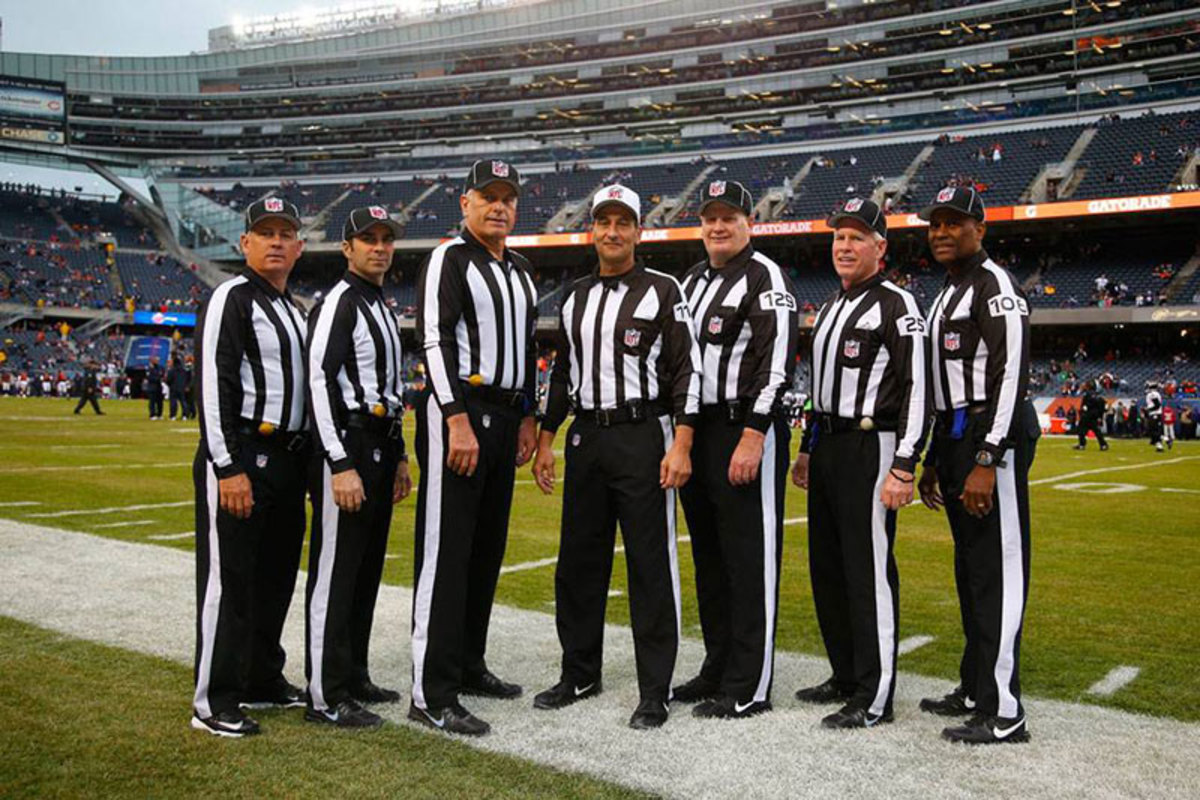
BOB WAGGONER
Field Judge
Age: 62
Home: Toledo, Ohio.
Years as NFL official: 17.
Outside job: Assistant supervisor of officials, Big Ten Conference, Mid-American Conference.
Crew role: Elder statesman, historian.
Personality: Flatline officiating lifer. Good complimentary partner to Steratore.
Q: How difficult is it to process information on the field in real time? Waggoner: “The average play is five to seven seconds long. In that time each official is making up to 20 decisions, and then the play goes up on the Jumbotron for everyone to see. Technology has certainly advanced the scrutiny. But it’s what we signed up for. When you put the shield on, you hold yourself to a higher standard. I think you should.”
* * *
DINO PAGANELLI
Back Judge
Age: 46
Home: Wyoming, Mich.
Years as NFL official: 8.
Outside job: High school history and phys ed teacher.
Crew role: Makes Saturday night dinner reservation on the road.
Personality: Quiet, patient, unflappable, always sure of his call.
Q: In light of the death of your wife, Christine, in 2011 [to melanoma], how do you view the pressure you face on the field? Paganelli: “Officiating isn’t pressure. Pressure is getting home at midnight Sunday from a game and making sure there’s milk in the refrigerator for breakfast for the kids, and making sure their clothes are washed and ready for the week.’’
* * *
BILL SCHUSTER
Umpire
Age: 55
Home: Livonia, N.Y.
Years as NFL official: 14.
Outside job: Owner, property and casualty insurance agency.
Crew role: Keeps guys loose. Throws barbs particularly at Steratore, Weatherford to cut tension.
Personality: Confident. Peacekeeper.
Q: What is it like for an umpire to control the trenches?Schuster: “We get called a lot of names. But there are players who help us police the problems. I have guys on the field I can go to to help me keep the peace.”
* * *
WAYNE MACKIE
Head Linesman
Age: 53
Home: Queens, N.Y.
Years as NFL official: 7.
Outside job: Director, Office of Neighborhood Enforcement Service, New York Housing Authority
Crew role: Travel arranger; in charge of morning-of-game devotional at hotel.
Personality: Soldier. Organizer.
Q: Is it tough sometimes to keep your cool on the field? Mackie: “We’re always told, ‘Stay above the fray.’ When you put the stripes on, it can’t be personal, and it never is with me. If someone is screaming at me, I say, ‘We’ll have this conversation when you calm down.’ ‘’
* * *
JEFF SEEMAN
Line Judge
Age: 50
Home: Chaska, Minn.
Years as NFL official: 12.
Outside job: Stockbroker.
Crew role: Game-day transportation coordinator.
Personality: Eager student. Well-schooled in technical side by late father Jerry, ex-NFL ref.
Q: How does this group mesh as a crew? Seeman: “We’re a bunch of dysfunctional guys doing a dysfunctional job who have to function at a super-high functioning level.”
* * *
MIKE WEATHERFORD
Side Judge
Age: 54
Home: Edmund, Okla.
Years as NFL official: 12.
Outside job:Marketing, oil and gas business.
Crew role: Banker—collects for Saturday night meal, tips for stadium workers.
Personality: Steely, reserved, unshakeable.
Q: Do you feel extra responsibility as the lone Native American (he is a Chickasaw) official in the NFL? Weatherford: “I had relatives run out of Mississippi on the Trail of Tears. So to be an NFL official, to work the Super Bowl especially, is such an honor. Not only for me, but for my entire family and for the Chickasaw Nation. Seeing my family at the Super Bowl is one of the thrills of my life.”
* * *
GENE STERATORE
Referee
Age: 50
Home: Washington, Pa.
Years as NFL official: 11 (referee for 8).
Outside jobs: NCAA Division I basketball official, owner of janitorial supply business.
Crew role: Captain of the ship. Leads conference calls, day-before-game meetings.
Personality: Leader. Soother in a crisis. Knows when to take one for the team.
Q: Is it an advantage to being easygoing on the field? Steratore: “It’s not, ‘Don’t worry, be happy.’ There is a level of focus, a level of confidence and a calmness where it looks like this isn’t a big deal. It is. I have a tendency to smile every once in a while into the camera. There’s a lot of cameras in those stadiums, and they might give a different perception of where I am. My calmness means I’m in the moment.”
Question or comment? Email us at talkback@themmqb.com.
